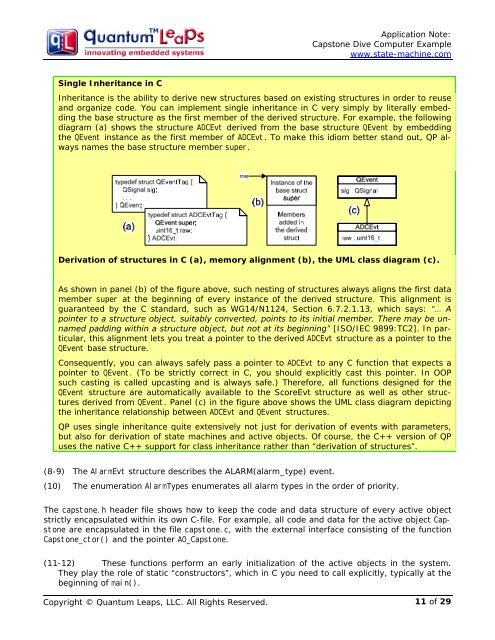AN: Capstone Dive Computer Example - Quantum Leaps
AN: Capstone Dive Computer Example - Quantum Leaps
AN: Capstone Dive Computer Example - Quantum Leaps
You also want an ePaper? Increase the reach of your titles
YUMPU automatically turns print PDFs into web optimized ePapers that Google loves.
Application Note:<br />
<strong>Capstone</strong> <strong>Dive</strong> <strong>Computer</strong> <strong>Example</strong><br />
www.state-machine.com<br />
Single Inheritance in C<br />
Inheritance is the ability to derive new structures based on existing structures in order to reuse<br />
and organize code. You can implement single inheritance in C very simply by literally embedding<br />
the base structure as the first member of the derived structure. For example, the following<br />
diagram (a) shows the structure ADCEvt derived from the base structure QEvent by embedding<br />
the QEvent instance as the first member of ADCEvt. To make this idiom better stand out, QP always<br />
names the base structure member super.<br />
Derivation of structures in C (a), memory alignment (b), the UML class diagram (c).<br />
As shown in panel (b) of the figure above, such nesting of structures always aligns the first data<br />
member super at the beginning of every instance of the derived structure. This alignment is<br />
guaranteed by the C standard, such as WG14/N1124, Section 6.7.2.1.13, which says: “… A<br />
pointer to a structure object, suitably converted, points to its initial member. There may be unnamed<br />
padding within a structure object, but not at its beginning” [ISO/IEC 9899:TC2]. In particular,<br />
this alignment lets you treat a pointer to the derived ADCEvt structure as a pointer to the<br />
QEvent base structure.<br />
Consequently, you can always safely pass a pointer to ADCEvt to any C function that expects a<br />
pointer to QEvent. (To be strictly correct in C, you should explicitly cast this pointer. In OOP<br />
such casting is called upcasting and is always safe.) Therefore, all functions designed for the<br />
QEvent structure are automatically available to the ScoreEvt structure as well as other structures<br />
derived from QEvent. Panel (c) in the figure above shows the UML class diagram depicting<br />
the inheritance relationship between ADCEvt and QEvent structures.<br />
QP uses single inheritance quite extensively not just for derivation of events with parameters,<br />
but also for derivation of state machines and active objects. Of course, the C++ version of QP<br />
uses the native C++ support for class inheritance rather than “derivation of structures”.<br />
(8-9) The AlarmEvt structure describes the ALARM(alarm_type) event.<br />
(10) The enumeration AlarmTypes enumerates all alarm types in the order of priority.<br />
The capstone.h header file shows how to keep the code and data structure of every active object<br />
strictly encapsulated within its own C-file. For example, all code and data for the active object <strong>Capstone</strong><br />
are encapsulated in the file capstone.c, with the external interface consisting of the function<br />
<strong>Capstone</strong>_ctor() and the pointer AO_<strong>Capstone</strong>.<br />
(11-12) These functions perform an early initialization of the active objects in the system.<br />
They play the role of static “constructors”, which in C you need to call explicitly, typically at the<br />
beginning of main().<br />
Copyright © <strong>Quantum</strong> <strong>Leaps</strong>, LLC. All Rights Reserved.<br />
11 of 29

















